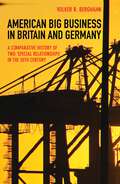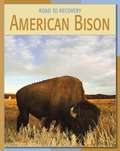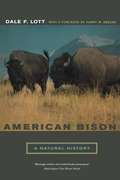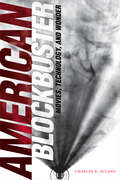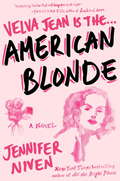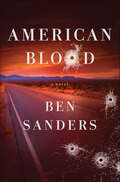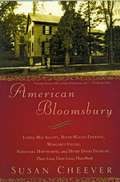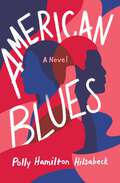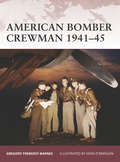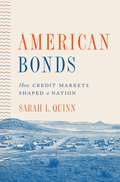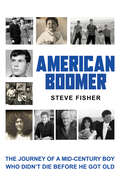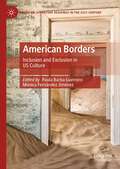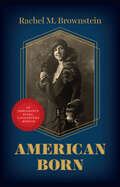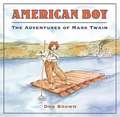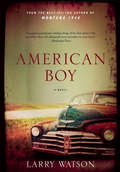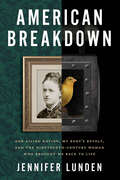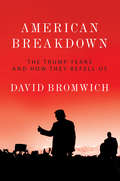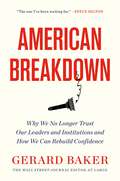- Table View
- List View
American Biblical Archaeology and Zionism: The Politics of Objectivity from William F. Albright to William G. Dever
by Brooke Sherrard KnorrThis book examines the relationship between several of the most prominent American biblical archaeologists and Zionism. While these scholars have been studied and historicized to some extent, little work has been done to understand their role in the history of the Palestinian–Israeli conflict. Two defining differences in the archaeologists’ arguments were their understanding of culture and their views on objectivity versus relativism. Brooke Sherrard Knorr argues that relativist archaeologists envisioned the ancient world as replete with cultural change and opposed the establishment of a Jewish state, while those who believed in scholarly objectivity both envisioned the ancient world’s ethnic boundaries as rigid and favored Zionism. Combining readings of the archaeologists’ writings with archival research, this book studies the views of William Foxwell Albright, Millar Burrows, Nelson Glueck, George Ernest Wright, Paul Lapp, and William G. Dever regarding the establishment of an ethno-national state in Palestine in detail. The volume culminates with an epilogue commenting on the relevance of this topic in the present regarding the political ramifications of archaeology in the Israeli–Palestinian conflict. American Biblical Archaeology and Zionism is of interest to students and scholars of Biblical and Near Eastern archaeology, American religious history, and the Israeli-Palestinian conflict, particularly its role in regional archaeology.
American Big Business in Britain and Germany: A Comparative History of Two "Special Relationships" in the 20th Century
by Volker R. BerghahnWhile America's relationship with Britain has often been deemed unique, especially during the two world wars when Germany was a common enemy, the American business sector actually had a greater affinity with Germany for most of the twentieth century. American Big Business in Britain and Germany examines the triangular relationship between the American, British, and German business communities and how the special relationship that Britain believed it had with the United States was supplanted by one between America and Germany.Volker Berghahn begins with the pre-1914 period and moves through the 1920s, when American investments supported German reconstruction rather than British industry. The Nazi seizure of power in 1933 led to a reversal in German-American relations, forcing American corporations to consider cutting their losses or collaborating with a regime that was inexorably moving toward war. Although Britain hoped that the wartime economic alliance with the United States would continue after World War II, the American business community reconnected with West Germany to rebuild Europe’s economy. And while Britain thought they had established their special relationship with America once again in the 1980s and 90s, in actuality it was the Germans who, with American help, had acquired an informal economic empire on the European continent.American Big Business in Britain and Germany uncovers the surprising and differing relationships of the American business community with two major European trading partners from 1900 through the twentieth century.
American Biodefense: How Dangerous Ideas about Biological Weapons Shape National Security
by Frank L. Smith IIIBiological weapons have threatened U.S. national security since at least World War II. Historically, however, the U.S. military has neglected research, development, acquisition, and doctrine for biodefense. Following September 11 and the anthrax letters of 2001, the United States started spending billions of dollars per year on medical countermeasures and biological detection systems. But most of this funding now comes from the Department of Health and Human Services rather than the Department of Defense. Why has the U.S. military neglected biodefense and allowed civilian organizations to take the lead in defending the country against biological attacks? In American Biodefense, Frank L. Smith III addresses this puzzling and largely untold story about science, technology, and national security. Smith argues that organizational frames and stereotypes have caused both military neglect and the rise of civilian biodefense. In the armed services, influential ideas about kinetic warfare have undermined defense against biological warfare. The influence of these ideas on science and technology challenges the conventional wisdom that national security policy is driven by threats or bureaucratic interests. Given the ideas at work inside the U.S. military, Smith explains how the lessons learned from biodefense can help solve other important problems that range from radiation weapons to cyber attacks.
American Bison (North American Animals Ser.)
by Steve PottsAmerican bison live only in North America. Learn all about these grassland giants and their habitats in American Bison.
American Bison (Road to Recovery)
by Barbara A. SomervillThe American bison was hunted to near extinction in the 1800s as settlers moved west across what is now the United States. Readers will learn about this animal that is a symbol of the American West and find out what steps were taken to help increase the American bison population.
American Bison: A Natural History
by Dale F. LottThis book, sixth in the series of 'Organisms and environments', presents a peek at the rich and unique ways of life that evolved in the heart of America and dismantles many of the myths about these ways of life, and about the bison in particular, to reveal the animal itself: ruminating, reproducing, and rutting in its full glory. He portrays the bison with an element of appeal to conserve its wildness and consider the importance of the wild in our lives. A beautifully written book by a recognized expert on one of the great icons of the American West.
American Blockbuster: Movies, Technology, and Wonder (Sign, Storage, Transmission)
by Charles R. AclandBen-Hur (1959), Jaws (1975), Avatar (2009), Wonder Woman (2017): the blockbuster movie has held a dominant position in American popular culture for decades. In American Blockbuster Charles R. Acland charts the origins, impact, and dynamics of this most visible, entertaining, and disparaged cultural form. Acland narrates how blockbusters emerged from Hollywood's turn to a hit-driven focus during the industry's business crisis in the 1950s. Movies became bigger, louder, and more spectacular. They also became prototypes for ideas and commodities associated with the future of technology and culture, accelerating the prominence of technological innovation in modern American life. Acland shows that blockbusters continue to be more than just movies; they are industrial strategies and complex cultural machines designed to normalize the ideologies of our technological age.
American Blonde
by Jennifer NivenA fearless and spirited pilot conquers Hollywood. Now can she survive movie stardom? In 1945, Velva Jean Hart is a bona fide war heroine. After a newsreel films her triumphant return to America, Metro-Goldwyn-Mayer promises to make her a star. They give her a new life story and a brand new name. As "Kit Rogers," she navigates the movie sets, recording sessions, parties, staged romances, and occasional backstabbing that accompany her newfound fame. She also navigates real-life romance, finding herself caught between a charismatic young writer and a sexy and enigmatic musician from her past. But when one of her best friends dies mysteriously and the most powerful studio in the world launches a cover-up, Velva Jean goes in search of the truth-- risking her own life, as well as her heart, in the process. Set during Hollywood's Golden Age and peopled with a cast of unforgettable characters, American Blonde will mesmerize readers of The Chaperone as well as fans of the Velva Jean series.
American Blonde: Book 4 in the Velva Jean series
by Jennifer NivenFrom the New York Times bestselling author of Holding Up the Universe and All the Bright Places (soon to be a major motion picture starring Elle Fanning), a fearless and spirited pilot conquers Hollywood. Now can she survive movie stardom? "A stunning talent."--Jonathan Eig, New York Times bestselling author of Get CaponeIn 1945, Velva Jean Hart is a bona fide war heroine. After a newsreel films her triumphant return to America, Metro-Goldwyn-Mayer promises to make her a star. They give her a new life story and a brand new name. As "Kit Rogers," she navigates the movie sets, recording sessions, parties, staged romances, and occasional backstabbing that accompany her newfound fame. She also navigates real-life romance, finding herself caught between a charismatic young writer and a sexy and enigmatic musician from her past. But when one of her best friends dies mysteriously and the most powerful studio in the world launches a cover-up, Velva Jean goes in search of the truth--risking her own life, as well as her heart, in the process. Set during Hollywood's Golden Age and peopled with a cast of unforgettable characters, American Blonde will mesmerize readers of The Chaperone as well as fans of the Velva Jean series.From the Trade Paperback edition.
American Blonde: Book 4 in the Velva Jean series
by Jennifer NivenFrom the New York Times bestselling author of Holding Up the Universe and All the Bright Places (soon to be a major motion picture starring Elle Fanning), a fearless and spirited pilot conquers Hollywood. Now can she survive movie stardom? "A stunning talent."--Jonathan Eig, New York Times bestselling author of Get CaponeIn 1945, Velva Jean Hart is a bona fide war heroine. After a newsreel films her triumphant return to America, Metro-Goldwyn-Mayer promises to make her a star. They give her a new life story and a brand new name. As "Kit Rogers," she navigates the movie sets, recording sessions, parties, staged romances, and occasional backstabbing that accompany her newfound fame. She also navigates real-life romance, finding herself caught between a charismatic young writer and a sexy and enigmatic musician from her past. But when one of her best friends dies mysteriously and the most powerful studio in the world launches a cover-up, Velva Jean goes in search of the truth--risking her own life, as well as her heart, in the process. Set during Hollywood's Golden Age and peopled with a cast of unforgettable characters, American Blonde will mesmerize readers of The Chaperone as well as fans of the Velva Jean series.From the Trade Paperback edition.
American Blood: A Novel (Marshall Grade #1)
by Ben SandersIn Ben Sanders's American Blood, a former undercover cop now in witness protection finds himself pulled into the search for a missing woman; film rights sold to Warner Bros with Bradley Cooper attached to star and produce.After a botched undercover operation, ex-NYPD officer Marshall Grade is living in witness protection in Santa Fe, New Mexico. Marshall's instructions are to keep a low profile: the mob wants him dead, and a contract killer known as the Dallas Man has been hired to track him down. Racked with guilt over wrongs committed during his undercover work, and seeking atonement, Marshall investigates the disappearance of a local woman named Alyce Ray.Members of a drug ring seem to hold clues to Ray's whereabouts, but hunting traffickers is no quiet task. Word of Marshall's efforts spreads, and soon the worst elements of his former life, including the Dallas Man, are coming for him.Written by a rising New Zealand star who has been described as "first rate," this American debut drops a Jack Reacher-like hero into the landscape of No Country for Old Men.
American Bloods: The Untamed Dynasty That Shaped a Nation
by John Kaag"American Bloods is an unflinching history of our nation . . . This is a breakout book for John Kaag—the natural extension of his genre-defining writing.” —Doris Kearns Goodwin, Pulitzer Prize–winning author of Leadership: In Turbulent Times"Kaag has a knack of stumbling upon treasures . . . The result is a thrilling and illuminating tale." —John Banville, The New StatesmanA history of a family spanning centuries and continents—one that unfolds into a new portrait of America.The Bloods were one of America’s first and most expansive pioneer families. They explored and laid claim to the frontiers—geographic, political, intellectual, and spiritual—that would become the very core of the United States. John Kaag’s American Bloods is the account of a remarkable American family, of its participation in the making of a nation, and of how its members embodied the elusive ideals enshrined in the Declaration of Independence. Inspired by the discovery of a mysterious manuscript in an old Massachusetts farmhouse, Kaag follows eight members of this family from the British Civil Wars in the seventeenth century through the founding of the colonies, the American Revolution, transcendentalism, the Industrial Revolution, the Civil War, and the rise of first-wave feminism, all the way to the beginning of the twentieth century.The Bloods were active participants in virtually every pivotal moment in American history, coming into contact with everyone from Emerson and Thoreau to John Brown, Frederick Douglass, Victoria Woodhull, and William James. The genealogy of the family tracks the ebb and flow of what Thoreau called “wildness,” an original untamed spirit that would recede in the making of America but would never be extinguished entirely. American Bloods is an enduring reminder of the risks and rewards that were taken in laying claim to the lands that would become the United States, and a composite portrait of America like no other.
American Bloomsbury
by Susan CheeverEven the most devoted readers of nineteenth-century American literature often assume that the men and women behind the masterpieces were as dull and staid as the era's static daguerreotypes. Susan Cheever's latest work, however, brings new life to the well-known literary personages who produced such cherished works as The Scarlet Letter, Moby-Dick, Walden, and Little Women. Rendering in full color the tumultuous, often scandalous lives of these volatile and vulnerable geniuses, Cheever's dynamic narrative reminds us that, while these literary heroes now seem secure of their spots in the canon, they were once considered avant-garde, bohemian types, at odds with the establishment. These remarkable men and women were so improbably concentrated in placid Concord, Massachusetts, that Henry James referred to the town as the "biggest little place in America." Among the host of luminaries who floated in and out of Concord's "American Bloomsbury" as satellites of the venerable intellect and prodigious fortune of Ralph Waldo Emerson were Henry David Thoreau -- perpetual second to his mentor in both love and career; Louisa May Alcott -- dreamy girl and ambitious spinster; Nathaniel Hawthorne -- dilettante and cad; and Margaret Fuller -- glamorous editor and foreign correspondent. Perhaps inevitably, given the smallness of the place and the idiosyncrasies of its residents, the members of the prestigious circle became both intellectually and romantically entangled: Thoreau serenaded an infatuated Louisa on his flute. Vying with Hawthorne for Fuller's attention, Emerson wrote the fiery feminist love letters while she resided (yards away from his wife) in his guest room. Herman Melville was, according to some, ultimately driven mad by his consuming and unrequited affection for Hawthorne. Far from typically Victorian, this group of intellectuals, like their British Bloomsbury counterparts to whom the title refers, not only questioned established literary forms, but also resisted old moral and social strictures. Thoreau, of course, famously retreated to a plot of land on Walden Pond to escape capitalism, pick berries, and ponder nature. More shocking was the group's ambivalence toward the institution of marriage. Inclined to bend the rules of its bonds, many of its members spent time at the notorious commune, Brook Farm, and because liberal theories could not entirely guarantee against jealousy, the tension of real or imagined infidelities was always near the surface. Susan Cheever reacquaints us with the sexy, subversive side of Concord's nineteenth-century intellectuals, restoring in three dimensions the literary personalities whose work is at the heart of our national history and cultural identity.
American Blues: A Novel
by Polly Hamilton HilsabeckA week after Easter 1973—following the lynching of Black church sexton Sam Jefferson—Lily Vida Wallace is dropped like an immigrant into Greenville, South Carolina. After returning home to Manhattan, Lily continues theological studies in anticipation of the overturn of a centuries-old, males-only priesthood and simultaneously struggles with her erratic engagement. When her fiancé flees following discovery of professional impropriety and Atlanta attorney Rodney Davis lands in her path, a new love grows—accelerating Lily’s understanding even as it challenges her naïveté about race. Some two decades later, high-profile interracial nuptials in Oakland, California, become the occasion for a reunion between the now Reverend Vida and Lucius Clay, the fiery journalist she met in South Carolina. Within weeks of their re-meeting, Lucius is dispatched to cover Black church burnings—beginning with Lily’s hometown in Texas. Writer Hilton Als recently commented: “We need to wake up to the fact that America is not one story. It is many, many, many stories.” American Blues offers no neat resolution. Instead, its timely story invites, as it tangles with, readers’ own assumptions and complex experiences of race and gender in America.
American Bomber Crewman 1941-45
by Gregory Barnes Sean O'BrogainGregory Fremont-Barnes examines the lives of the American Bomber Crewmen of the Eighth Air Force, "The Mighty Eighth", who crewed, maintained and repaired the Boeing B-17 Flying Fortresses and the B-24 Liberators that flew from the airfields of Norfolk and Suffolk and other counties of England during World War II (1939-1945). He highlights the physical and psychological strain placed on these brave men. Long bombing missions called for brute strength to control the aircraft and extraordinary endurance to fly for hours at 20,000 feet at temperatures below freezing in unheated, unpressurized cabins. Then there were Luftwaffe fighters and anti-aircraft fire to contend with and it required incredible skill and some luck to return from a mission unscathed. This book is a fitting tribute to these often uncelebrated heroes who took the war deep into the Third Reich, as well as a fascinating historical account of the experiences they went through.
American Bonds: How Credit Markets Shaped a Nation (Princeton Studies in American Politics: Historical, International, and Comparative Perspectives #164)
by Sarah L. QuinnHow the American government has long used financial credit programs to create economic opportunitiesFederal housing finance policy and mortgage-backed securities have gained widespread attention in recent years because of the 2008 financial crisis, but issues of government credit have been part of American life since the nation’s founding. From the 1780s, when a watershed national land credit policy was established, to the postwar foundations of our current housing finance system, American Bonds examines the evolution of securitization and federal credit programs. Sarah Quinn shows that since the Westward expansion, the U.S. government has used financial markets to manage America’s complex social divides, and politicians and officials across the political spectrum have turned to land sales, home ownership, and credit to provide economic opportunity without the appearance of market intervention or direct wealth redistribution.Highly technical systems, securitization, and credit programs have been fundamental to how Americans determined what they could and should owe one another. Over time, government officials embraced credit as a political tool that allowed them to navigate an increasingly complex and fractured political system, affirming the government’s role as a consequential and creative market participant. Neither intermittent nor marginal, credit programs supported the growth of powerful industries, from railroads and farms to housing and finance; have been used for disaster relief, foreign policy, and military efforts; and were promoters of amortized mortgages, lending abroad, venture capital investment, and mortgage securitization.Illuminating America’s market-heavy social policies, American Bonds illustrates how political institutions became involved in the nation’s lending practices.
American Boomer
by Steve FisherOK, Boomer… this is the book you&’ve been waiting for! A memoir by one of your own, about your time and tribulations, which will take you down memory lane and may even remind you of yourself as a child of the Greatest Generation.As a front-line baby boomer, Steve Fisher was a youngster in the 1950s and came of age in the turbulent 1960s. Never one to stay within the proscribed parameters and never too big on rules, he followed his own path and made choices that were, unfortunately, often to his own detriment. American Boomer traces the highs and lows of his exceptional journey, including his time as a musician, a radio disc-jockey, and ultimately, a writer. Funny and poignant, uplifting and heart-breaking, American Boomer is a hard and honest look at a son of the Greatest Generation who didn&’t die before he got old.If you&’re a baby boomer, much of the vernacular in this book will be familiar to you. If you&’re a younger reader… that&’s why there&’s Google.
American Borders: Inclusion and Exclusion in US Culture (American Literature Readings in the 21st Century)
by Paula Barba Guerrero Mónica Fernández JiménezAmerican Borders: Inclusion and Exclusion in US Culture provides an overview of American culture produced in a range of contexts, from the founding of the nation to the age of globalization and neoliberalism, in order to understand the diverse literary landscapes of the United States from a twenty-first century perspective. The authors confront American exceptionalism, discourses on freedom and democracy, and US foundational narratives by reassessing the literary canon and exploring ethnic literature, culture, and film with a focus on identity and exclusion. Their contributions envision different manifestations of conviviality and estrangement and deconstruct neoliberal slogans, analyzing hospitable inclusion in relation to national history and ideologies. By looking at representations of foreignness and conditional belonging in literature and film from different ethnic traditions, the volume fleshes out a new border dialectic that conveys the heterogeneity of American boundaries beyond the opposition inside/outside.
American Born: An Immigrant's Story, a Daughter's Memoir (Emersion: Emergent Village Resources For Communities Of Faith Ser.)
by Rachel M. BrownsteinAn incisive memoir of Rachel M. Brownstein’s seemingly quintessential Jewish mother, a resilient and courageous immigrant in New York. When she arrived alone in New York in 1924, eighteen-year-old Reisel Thaler resembled the other Yiddish-speaking immigrants from Eastern Europe who accompanied her. Yet she already had an American passport tucked in her scant luggage. Reisel had drawn her first breath on the Lower East Side of Manhattan in 1905, then was taken back to Galicia (in what is now Poland) by her father before she turned two. She was, as she would boast to the end of her days, “American born.” The distinguished biographer and critic Rachel M. Brownstein began writing about her mother Reisel during the Trump years, dwelling on the tales she told about her life and the questions they raised about nationalism, immigration, and storytelling. For most of the twentieth century, Brownstein’s mother gracefully balanced her identities as an American and a Jew. Her values, her language, and her sense of timing inform the imagination of the daughter who recalls her in her own old age. The memorializing daughter interrupts, interprets, and glosses, sifting through alternate versions of the same stories using scenes, songs, and books from their time together. But the central character of this book is Reisel, who eventually becomes Grandma Rose—always watching and judging, singing, baking, and bustling. Living life as the heroine of her own story, she reminds us how to laugh despite tragedy, find our courage, and be our most unapologetically authentic selves.
American Boundaries: The Nation, The States, The Rectangular Survey
by Bill Hubbard Jr.For anyone who has looked at a map of the United States and wondered how Texas and Oklahoma got their Panhandles, or flown over the American heartland and marveled at the vast grid spreading out in all directions below, American Boundaries will yield a welcome treasure trove of insight. The first book to chart the country's growth using the boundary as a political and cultural focus, Bill Hubbard's masterly narrative begins by explaining how the original thirteen colonies organized their borders and decided that unsettled lands should be held in trust for the common benefit of the people. Hubbard goes on to show--with the help of photographs, diagrams, and hundreds of maps--how the notion evolved that unsettled land should be divided into rectangles and sold to individual farmers, and how this rectangular survey spread outward from its origins in Ohio, with surveyors drawing straight lines across the face of the continent. Mapping how each state came to have its current shape, and how the nation itself formed within its present borders, American Boundaries will provide historians, geographers, and general readers alike with the fascinating story behind those fifty distinctive jigsaw-puzzle pieces that together form the United States.
American Boy
by Don BrownOur popular image of Mark Twain is of a gruV, gray-haired eccentric, the outspoken literary giant who created enduring novels such as The Adventures of Tom Sawyer and The Adventures of Huckleberry Finn. But once upon a time, Mark Twain was a boy named Samuel Clemens. His birth on November 30, 1835, coincided with the appearance of Halley’s comet streaking across the sky. A dreamer, a prankster, a lover of great tales, Sam Clemens spent his boyhood years "in high feather,” living out adventures along the banks of the mighty Mississippi River. His beloved river would eventually carry Mark Twain far beyond Hannibal, Missouri, but he would return to the freedom, innocence, and vitality of his youth again and again in his writing. In glowing watercolors and spirited text, Don Brown reveals the glad morning of Twain’s life, now the classic American boyhood, and the forces that inspired his funny, irreverent, insightful, and groundbreaking works of fiction.
American Boy: A Novel
by Larry WatsonWe were exposed to these phenomena in order that we might learn something, but of course the lessons we learn are not always what was intended. So begins Matthew Garth's story of the fall of 1962, when the shooting of a young woman on Thanksgiving Day sets off a chain of unsettling events in small-town Willow Falls, Minnesota. Matthew first sees Louisa Lindahl in Dr. Dunbar's home office, and at the time her bullet wound makes nearly as strong an impression as her unclothed body. Fueled over the following weeks by his feverish desire for this mysterious woman and a deep longing for the comfort and affluence that appears to surround the Dunbars, Matthew finds himself drawn into a vortex of greed, manipulation, and ultimately betrayal. Immersive, heart-breaking, and richly evocative of a time and place, this long-awaited new novel marks the return of a great American storyteller.
American Breakdown: Our Ailing Nation, My Body's Revolt, and the Nineteenth-Century Woman Who Brought Me Back to Life
by Jennifer LundenA Silent Spring for the human body, this wide-ranging, genre-crossing literary mystery interweaves the author’s quest to understand the source of her own condition with her telling of the story of the chronically ill 19th-century diarist Alice James—ultimately uncovering the many hidden health hazards of life in America.When Jennifer Lunden became chronically ill after moving from Canada to Maine, her case was a medical mystery. Just 21, unable to hold a book or stand for a shower, she lost her job and consigned herself to her bed. The doctor she went to for help told her she was “just depressed.”After suffering from this enigmatic illness for five years, she discovered an unlikely source of hope and healing: a biography of Alice James, the bright, witty, and often bedridden sibling of brothers Henry James, the novelist, and William James, the father of psychology. Alice suffered from a life-shattering illness known as neurasthenia, now often dismissed as a “fashionable illness.”In this meticulously researched and illuminating debut, Lunden interweaves her own experience with Alice’s, exploring the history of medicine and the effects of the industrial revolution and late-stage capitalism to tell a riveting story of how we are a nation struggling—and failing—to be healthy.Although science—and the politics behind its funding—has in many ways let Lunden and millions like her down, in the end science offers a revelation that will change how readers think about the ecosystems of their bodies, their communities, the country, and the planet.
American Breakdown: The Trump Years and How They Befell Us
by David BromwichHow Trump got to the Oval Office—and how both parties and the mainstream media are keeping him thereDonald Trump’s residency in the White House is not an accident of American history, and it can’t be blamed on a single cause. In American Breakdown, David Bromwich provides an essential analysis of the forces in play beneath the surface of our political system. His portraits of political leaders and overarching narrative bring to life the events and machinations that have led America to a collective breakdown.The political conditions of the present crisis were put in place over fifty years ago, with the expansion of the Vietnam War and the lies and coverups that brought down Nixon. Since then, every presidency has further centralized and strengthened executive power. The truly catastrophic event in American life was the invention by George W. Bush and Dick Cheney of the War on Terror, designed to last for generations. Barack Obama’s practice of “reconciliation without truth”—sparing CIA torturers and Wall Street bankers—deepened the distrust and anger of an electorate that has rallied around Trump.An unsparing account of the degradation of US democracy, American Breakdown is essential to our evaluation of its prospects. Arguing that Trump’s re-election seems just as likely as impeachment, Bromwich turns his attention to the new struggles within the Democratic Party on immigration, foreign policy, and the Green New Deal.American Breakdown will be a crucial reference point in the political debate around the upcoming presidential election—a contest in which the forces that created Donald Trump show no sign of letting up.
American Breakdown: Why We No Longer Trust Our Leaders and Institutions and How We Can Rebuild Confidence
by Gerard BakerFrom the former editor-in-chief of the Wall Street Journal, a must-read account of how America suffers from a &“trust deficit&” that has weakened its cornerstone institutions and divided our society. AMERICAN BREAKDOWN dissects how, in the space of a generation, the pillars that sustained the once-dominant superpower have been dangerously eroded. From government to business, from media to medicine—the strength and security of the American experiment have been weakened by a widening gap between the elites who control these institutions and the public. At the root of this breakdown is a precipitous fall in Americans&’ trust in their political, business and cultural leaders. As Baker writes, &“This pathology of distrust across American society is eating the country away from the inside.&” Millions of Americans say they have little faith in their country's future, and no longer seem to have trust in their leaders, in their important social and civil institutions, even in their common values and ideals, or ultimately in each other. America in fact hasn&’t failed. Americans have been failed—misled by inept and deceitful political leaders, deserted by predatory and cynical corporate chiefs, and, above all, betrayed by a cultural elite that has exploited the very freedom this country provided in order to destroy it. AMERICAN BREAKDOWN is a deep analysis and thought-provoking account that explores the ways in which Americans have been let down and offers solutions for how we rebuild trust and reclaim purpose for a better future.

